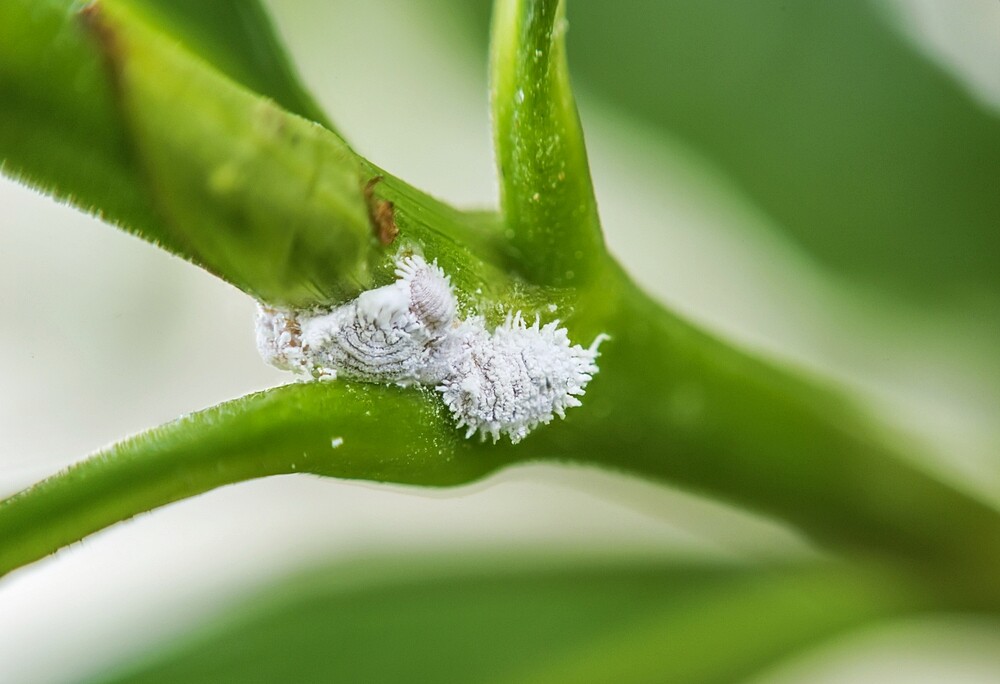Mealybugs are annoying little pests that attack our plants and cause them to die. You can find out how to control mealybugs and what you need to know here!
What are mealybugs?
- Mealybugs (Pseudococcidae) are root lice.
- They are a subfamily of scale insects and can be recognized by their pink, light brown or white bodies surrounded by white hairs.
- These white cotton-like balls are the protective cover for the pests. They leave behind white “smear marks”.
- Mealybugs can grow between 1 mm and 12 mm in size.
Are mealybugs dangerous?
Mealybugs damage the plants until they die. The pests suck out the plant sap, inject a poison that damages the plant and leave honeydew – a sticky substance that causes sooty dew.
The female mealybugs fertilise themselves and can lay up to 600 eggs within a short time. These eggs can hide anywhere: in the substrate, on the roots, in the leaf axils or leaves. This is the reason why a large-area infestation quickly occurs, which must be counteracted immediately. Otherwise, the pests will spread to other plants and infest all indoor plants.
Which plants are affected?
- Mealybugs prefer to settle on herbaceous plants, although indoor and natural plants can be equally affected.
- Plants that are frequently affected: orchids, pineapple plants, citrus plants, cacti, rubber trees, yuccas, passion flower, daisies, grasses, legumes, poinsettia
- Ants are often an indication that mealybugs have settled down. The insects are attracted by the honeydew of the mealybugs.
Fight mealybugs: You can do that!
Treat plant
- Isolate the affected plant immediately and place it in a bright and cool room.
- Cut off the affected plant parts and dispose of them.
- Soak a cloth in spirit and remove the lice with it. Test beforehand in an inconspicuous place to see if the plant can tolerate the alcohol.
- Hold the plant diagonally over the shower and shower it off.
- Dilute 15 ml spirit, 1 l water and 15 ml curd soap and pour the liquid into a spray bottle. Spray the solution every two to three days on the plant lance. Caution: Sensitive plants, such as the orchid, should not be sprayed with the solution. In this case it is recommended to apply the agent by brush.
- Resistant cacti on the other hand can be rubbed off directly with methylated spirits in case of an infestation.
Repot plant
- When the mealybugs have settled at the roots, you have to repot the plant.
- For this purpose, the roots must also be freed from any substrate. If necessary, cut off rotten spots.
- Clean the roots with a strong water jet.
- You should disinfect the pot thoroughly with alcohol and preferably put it in the dishwasher.
- Use only new substrate for potting, which you should place in the oven at 200 degrees for 20 minutes to kill any eggs. The old infected substrate should be disposed of immediately. Attention: Do not throw it on the compost, otherwise the lice may spread further in the garden. The organic waste bin is the right place instead.
Fight mealybugs: With beneficial insects
The natural predators of mealybugs are ichneumon flies, lacewing larvae and the Australian ladybird.
- Ichneumon flies: ichneumon flies are suitable for the garden. Here the beneficial insects can be attracted by pieces of wood with holes three millimetres in size.
- Lacewings: Lacewings are suitable for indoor use and can attack mealy bugs within two weeks. Make sure that the plants are placed directly next to each other, as this is the only way the larvae can migrate from plant to plant. If the infestation is more severe, you must encourage the development of a subsequent generation. This is best done with diluted honey, which is used in small bowls as a food source.
- Australian ladybird: The ladybird needs a temperature of at least 20 degrees and high humidity. They are best exposed at dusk and according to instructions. Keep the rooms closed for some time once you have spread the beetles on the plants. The ladybirds can be kept comfortably indoors, as they will later migrate or die when all food is used up.
Mealybugs: How to prevent an infestation
- If you buy a new plant, you should check it thoroughly for mealybugs.
- Too little light and warm heating air provide optimal living conditions for the mealy bugs – sufficient light and good ventilation prevents infestation.
- Avoid excessive nitrogen fertilization.
- General care mistakes weaken the plant and make it more susceptible to pests.

